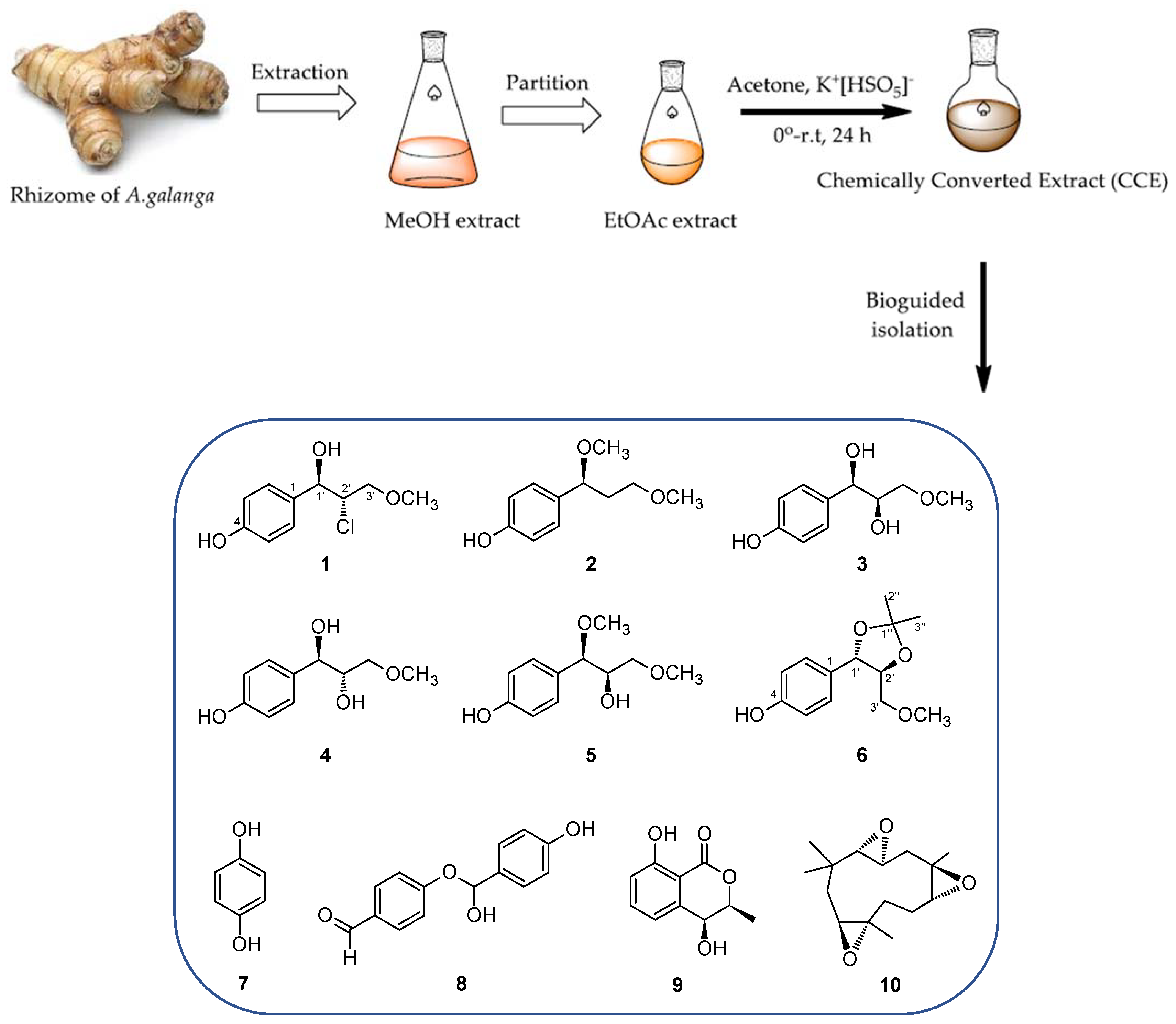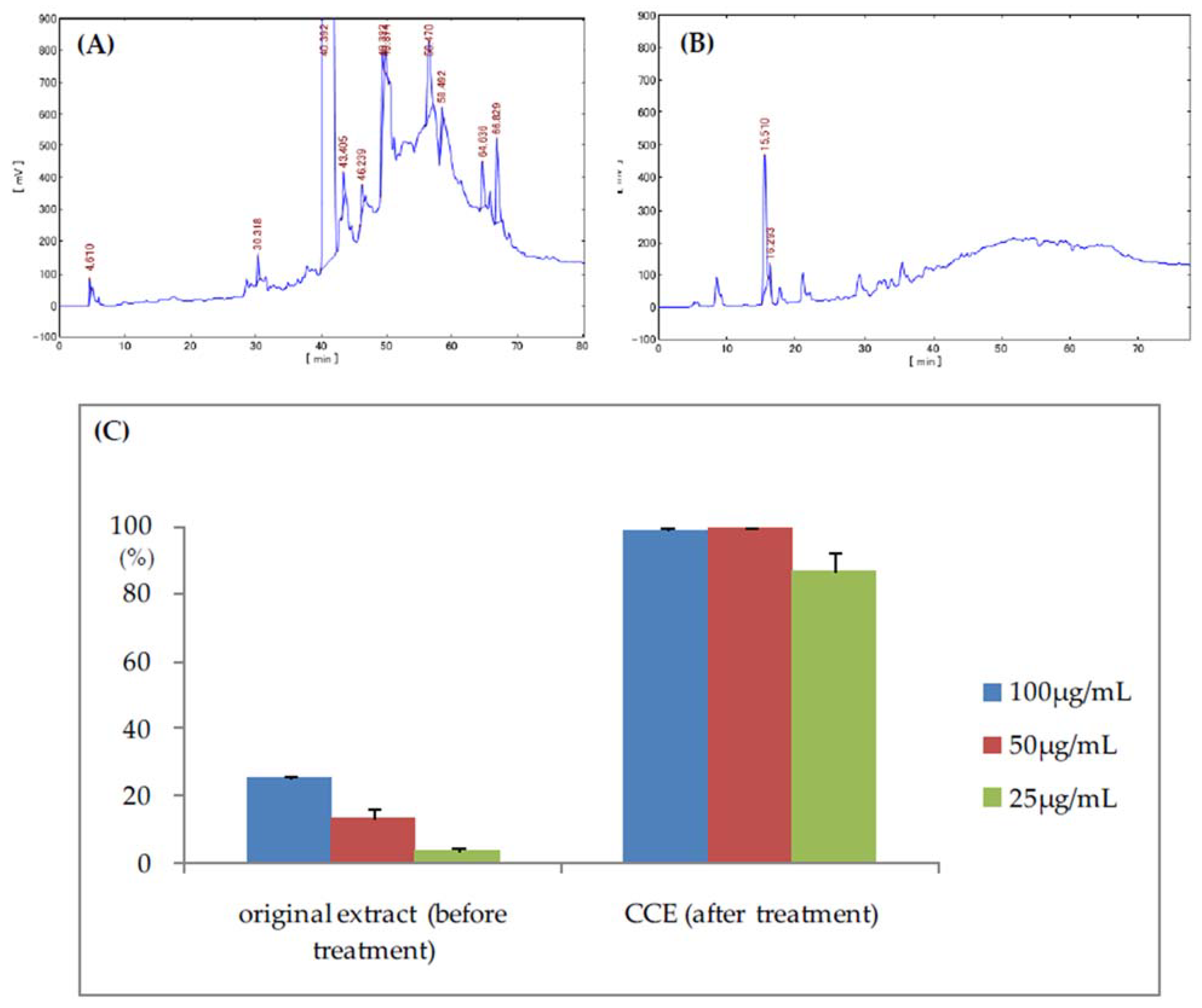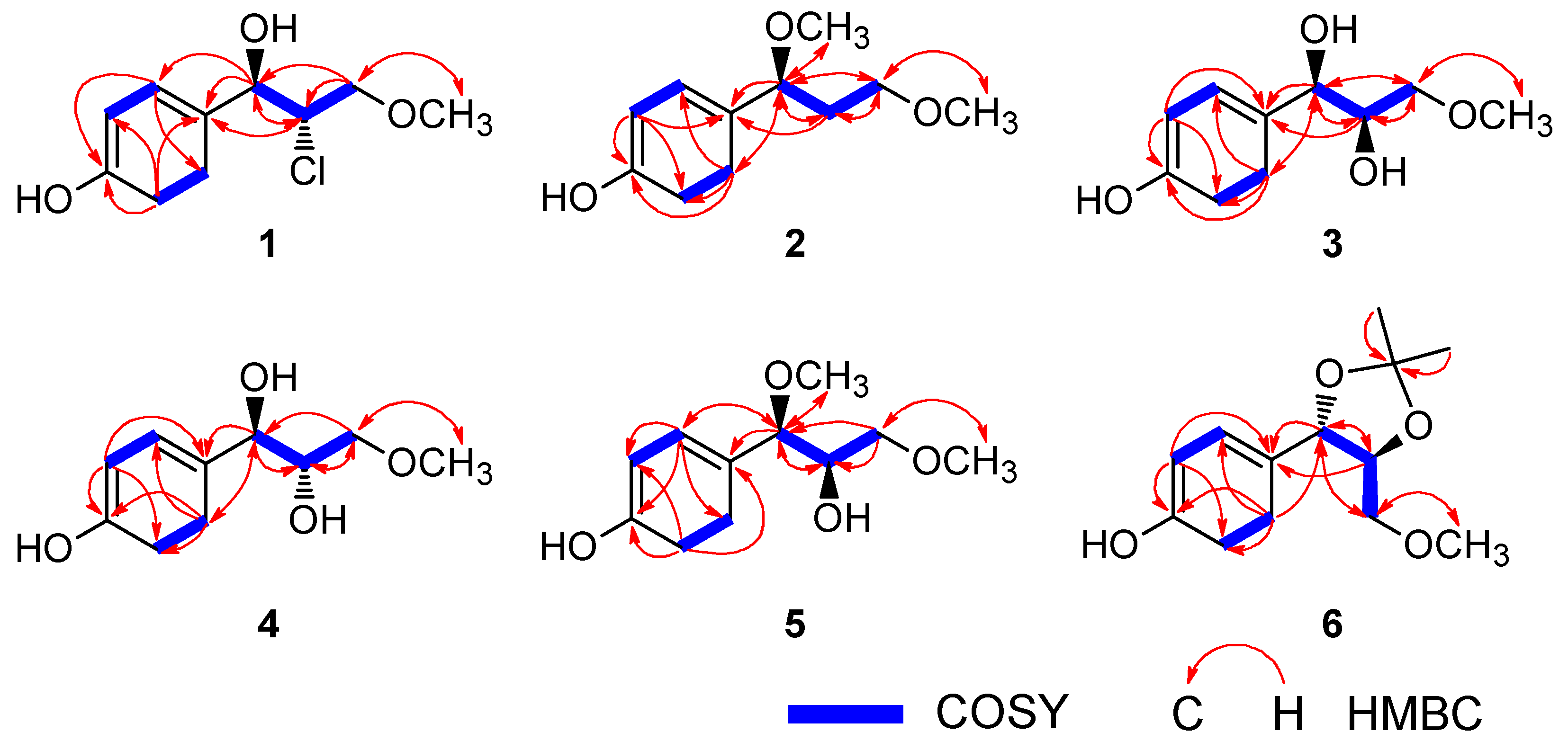Six New Phenylpropanoid Derivatives from Chemically Converted Extract of Alpinia galanga (L.) and Their Antiparasitic Activities
Abstract
1. Introduction
2. Results and Discussion
2.1. Isolation of Chemical Components of Chemically Converted Extract of Alpinia Galanga
2.2. Antiparasitic Activity Examinations of the Isolated Compounds
3. Materials and Methods
3.1. General Methods
3.2. Plant Material
3.3. Preparation of Chemically Converted Extract of A. galanga and Isolation of Compounds 1–10
3.4. Biological Assay of Compounds 1–10
4. Conclusions
Supplementary Materials
Author Contributions
Funding
Data Availability Statement
Acknowledgments
Conflicts of Interest
Sample Availability
References
- Neglected Tropical Diseases: Fact Sheets Relating to NTDs. Available online: https://www.who.int/neglected_diseases/mediacentre/factsheet/en/ (accessed on 17 February 2021).
- Malaria: Fact Sheets Relating to Malaria. Available online: https://www.who.int/en/news-room/fact-sheets/detail/malaria (accessed on 17 February 2021).
- Trypanosomiasis, Human African (Sleeping Sickness): Fact Sheets. Available online: https://www.who.int/news-room/fact-sheets/detail/trypanosomiasis-human-african-(sleeping-sickness) (accessed on 17 February 2021).
- Jesse, W.-H.L.; Vederas, J.C. Drug Discovery and Natural Products: End of an Era or an Endless Frontier? Science 2009, 325, 161–165. [Google Scholar]
- Newman, D.J.; Cragg, G.M. Natural Products as Sources of New Drugs from 1981 to 2014. J. Nat. Prod. 2016, 79, 629–661. [Google Scholar] [CrossRef]
- The Dictionary of Natural Products. CRC Press. Available online: https://www.routledge.com/go/the_dictionary_of_natural_products (accessed on 17 February 2021).
- Salazar, M.O.; Ramallo, I.A.; Micheloni, O.; Sierra, M.G.; Furlan, R.L. Chemically engineered extracts: Bioactivity alteration through sulfonylation. Bioorganic Med. Chem. Lett. 2009, 19, 5067–5070. [Google Scholar] [CrossRef] [PubMed]
- Ramallo, I.A.; Salazar, M.O.; Méndez, L.; Furlán, R.L.E. Chemically Engineered Extracts: Source of Bioactive Compounds. Accounts Chem. Res. 2011, 44, 241–250. [Google Scholar] [CrossRef] [PubMed]
- López, S.N.; Ramallo, I.A.; Sierra, M.G.; Zacchino, S.A.; Furlan, R.L.E. Chemically engineered extracts as an alternative source of bioactive natural product-like compounds. Proc. Natl. Acad. Sci. USA 2006, 104, 441–444. [Google Scholar] [CrossRef]
- Wu, T.; Jiang, C.; Wang, L.; Morris-Natschke, S.L.; Miao, H.; Gu, L.; Xu, J.; Lee, K.H.; Gu, Q. 3,5-Diarylpryrazole Derivatives Obtained by Ammonolysis of the Total Flavonoids from Chrysanthemum indicum extract Show Potential for the Treatment of Alzheimer’s Disease. J. Nat. Prod. 2015, 78, 1593–1599. [Google Scholar] [CrossRef] [PubMed]
- Mendez, L.; Salazar, M.O.; Ramallo, I.A.; Furlán, R.L.E. Brominated Extracts as Source of Bioactive Compounds. ACS Comb. Sci. 2010, 13, 200–204. [Google Scholar] [CrossRef] [PubMed]
- Kawamura, T.; Matsubara, K.; Otaka, H.; Tashiro, E.; Shindo, K.; Yanagita, R.C.; Irie, K.; Imoto, M. Generation of ‘Unnatural Natural Product’ library and identification of a small molecule inhibitor of XIAP. Bioorganic Med. Chem. 2011, 19, 4377–4385. [Google Scholar] [CrossRef] [PubMed]
- Kikuchi, H.; Sakurai, K.; Oshima, Y. Development of Diversity-Enhanced Extracts of Curcuma zedoria and Their New Ses-quiterpene-like Compounds. Org. Lett. 2014, 16, 1916–1919. [Google Scholar] [CrossRef] [PubMed]
- Ramallo, I.A.; Sierra, M.G.; Furlan, R.L.E. Discovery of β-Glucosidase Inhibitors from a Chemically Engineered Extract Prepared through Ethanolysis. Med. Chem. 2012, 8, 112–117. [Google Scholar] [CrossRef]
- Padalia, R.C.; Verma, R.S.; Sundaresan, V.; Chanotiya, C.S. Chemical Diversity in the Genus Alpinia (Zingiberaceae): Com-parative Composition of Four Alpinia Species Grown in Northern India. Chem. Biodivers. 2010, 7, 2076–2087. [Google Scholar] [CrossRef]
- Zhu, X.-L.; Yang, M.-H.; Luo, J.-G.; Huang, X.-F.; Kong, L.-Y. A New Phenylpropanoid from Alpiniagalanga. Chin. J. Nat. Med. 2009, 7, 19–20. [Google Scholar] [CrossRef]
- Matsuda, H.; Morikawa, T.; Managi, H.; Yoshikawa, M. Antiallergic Principles from Alpinia galangal: Structural Requirements of Phenylpropanoids for Inhibition of Degranulation and Release of TNF-α and IL-4 in RBL-2H3 Cells. Bioorg. Med. Chem. 2003, 13, 3197–3202. [Google Scholar] [CrossRef]
- Zhao, L.; Chen, L.-Y.; Liang, J.-Y. Two new phenylpropanoids isolated from the rhizomes of Alpiniagalanga. Chin. J. Nat. Med. 2012, 10, 370–373. [Google Scholar]
- Chourasiya, S.S.; Sreedhar, E.; Babu, K.S.; Shankaraia, N.; Nayak, L.; Ramakrishna, S.; Sravani, S.; Rao, B.M.V. Isolation, Synthesis and Biological Evaluation of Phenylpropanoids from the Rhizomes of Alpiniagalanga. Nat. Prod. Commun. 2013, 8, 1741–1746. [Google Scholar]
- Laksmi, S.; Sandra, S.; Rahul, B.S.; Saikant, B.; Vani, M.; Manoj, G.; Padmaja, G.; Remani, P. In vitro and in vivo studies of 5,7-dihydroxy flavones isolated from Alpinia galangal (L.) against human lung cancer and ascetic lymphoma. Med. Chem. Res. 2019, 28, 39–51. [Google Scholar] [CrossRef]
- Morikawa, T.; Ando, S.; Matsuda, H.; Kataoka, S.; Muraoka, O.; Yoshikawa, M. Inhibitors of Nitric Oxide Production from the Rhizomes of Alpiniagalangal: Structures of New 8-9′ Linked Neolignans and Sesquineolignan. Chem. Pharm. Bull. 2005, 53, 625–630. [Google Scholar] [CrossRef]
- Oonmetta-aree, J.; Suzuki, T.; Gasaluck, P.; Eumkeb, G. Antimicrobial properties and action of galangal (Alpiniagalanga Linn.) on Staphylococccus aureus. LWT 2006, 39, 1214–1220. [Google Scholar] [CrossRef]
- Gupta, P.; Bhatter, P.; D’souza, D.; Tolani, M.; Daswani, P.; Tetali, P.; Birdi, T. Evaluating the anti Mycobacterium tuberculosis activity of Alpiniagalanga (L.) Willd. Axenically under reducing oxygen conditions and in intracellular assays. BMC Complement. Altern. Med. 2014, 14, 84–92. [Google Scholar] [CrossRef]
- Tang, X.; Xu, C.; Yagiz, Y.; Simonne, A.; Marshall, M.R. Phytochemical profiles, and antimicrobial and antioxidant activities of greater galangal [Aplinia galangal (Linn.) Swartz.] flowers. Food Chem. 2018, 255, 300–308. [Google Scholar] [CrossRef]
- Chansriniyom, C.; Bunwatcharaphansakun, P.; Eaknai, W.; Nalinratana, N.; Ratanawong, A.; Khongkow, M.; Leuchapudi-porn, R. A synergistic combination of Phyllanthus emblica and Alpiniagalanga against H2O2-induced oxidative stress and lipid peroxidation in human ECV304 cells. J. Funct. Foods 2018, 43, 44–54. [Google Scholar] [CrossRef]
- Singh, J.C.H.; Alagarsamy, V.; Diwan, P.V.; Kumar, S.S.; Nisha, J.C.; Reddy, Y.N. Neuroprotective effect of Alpiniagalanga (L) fractions on Aβ(25-35) induced amnesia in mice. J. Ethnopharmacol. 2011, 138, 85–91. [Google Scholar] [CrossRef]
- Seo, J.-W.; Cho, S.-C.; Park, S.-J.; Lee, E.-J.; Lee, J.-H.; Han, S.-S.; Pyo, B.S.; Park, D.-H.; Kim, B.-H. 1′-Acetoxychavicol Acetate Isolated from Alpiniagalangal Ameliorates Ovalbumin-Induced Asthma in Mice. PLoS ONE 2013, 8, e56447. [Google Scholar] [CrossRef] [PubMed]
- Yoshiaki, M.; Ninomiya, K.; Nishi, R.; Kamei, I.; Katsuyama, Y.; Imagawa, T.; Chaipech, S.; Muraoka, O.; Morikawa, T. Mel-anogenesis inhibitory activity of a 7-O-9′-linked neolignan from Alpiniagalangafruit. Bioorg. Med. Chem. 2016, 24, 6215–6224. [Google Scholar]
- Thanh, B.L.; Claire, B.; Duc Trong, N.; Marie-Paule, M.; Joelle, Q.L. In vitro Anti-Leishmanial Activity of Essential Oils Ex-tracted from Vietnamese Plants. Molecules 2017, 22, 1071–1083. [Google Scholar]
- Yang, D.; Wong, M.-K.; Yip, Y.-C. Epoxidation of Olefins Using Methyl(trifluoromethyl)dioxirane Generated in Situ. J. Org. Chem. 1995, 60, 3887–3889. [Google Scholar] [CrossRef]
- Asaumi, S.; Kawakami, S.; Sugimoto, S.; Matsunami, K.; Otsuka, H.; Shinzato, T. Alkylated Benzoquinones: Ardisiaquinones A–H from the Leaves of Ardisiaquinquegona and Their Anti-Leishmania Activity. Chem. Pharm. Bull. 2018, 66, 757–763. [Google Scholar] [CrossRef]
- Bernini, R.; Coratti, A.; Provenzano, G.; Fabrizi, G.; Tofani, D. Oxidation of aromatic aldehydes and ketones by H2O2/CH3ReO3 in ionic liquids: A catalytic efficient reaction to achieve dihydric phenols. Tetrahedron 2005, 61, 1821–1825. [Google Scholar] [CrossRef]
- Tao, P.; Meng, Q.-H.; Zhang, H.-F.; Zhang, C.-H.; Fang, N.-H. Analysis of impurities in 4-hydrobenzaldehyde by HPLC, combined with mass spectroscopy. Ranliao Yu Ranse 2005, 42, 59–60. [Google Scholar]
- Rivera-Chavez, J.; Figueroa, M.; Gonzalez, M.C.; Glenn, A.E.; Mata, R. α-Glucosidase Inhibitors from a Xylariafeejeensis Associated with Hintonialatiflora. J. Nat. Prod. 2015, 78, 730–735. [Google Scholar] [CrossRef]
- Hayano, K.; Mochizu, K. First Isolation and Determination of Three Humulene Triepoxides. Heterocycles 1997, 45, 1573–1577. [Google Scholar] [CrossRef]
- Swamy, P.; Kumar, M.A.; Reddy, M.M.; Naresh, M.; Srujana, K.; Narender, N. The vicinal functionalization of olefins: A facile route to the direct synthesis of β-chlorohydrins and β-chloroethers. RCS Adv. 2014, 4, 26288–26294. [Google Scholar] [CrossRef]
- Yang, X.-W.; Li, S.-M.; Li, Y.-L.; Feng, L.; Shen, Y.-H.; Lin, S.; Tian, J.-M.; Zeng, H.-W.; Wang, N.; Steinmetz, A.; et al. Chemical constituents of Abies delavayi. Phytochemistry 2014, 105, 164–170. [Google Scholar] [CrossRef]
- Li, Y.-L.; Gao, Y.-X.; Jin, H.-Z.; Shan, L.; Chang, W.-L.; Yang, X.-W.; Zeng, H.-W.; Wang, N.; Steinmetz, A.; Zhang, W.-D. Chemical constituents of Abies fabri. Phytochemistry 2015, 117, 135–143. [Google Scholar] [CrossRef] [PubMed]
- Chakraborty, I.; Chatterjee, S.; Manna, A.; Bhaumik, T. Confirmation of the stereochemistry of two naturally occurring epimeric phenylpropanoids via synthesis: Elucidation of hitherto unknown full stereostructures. Tetrahedron Lett. 2019, 60, 1597–1599. [Google Scholar] [CrossRef]
- Balamurugan, R.; Kothapalli, R.B.; Thota, G.K. Gold-Catalysed Activation of Epoxides: Application in the Synthesis of Bicyclic Ketals. Eur. J. Org. Chem. 2011, 2011, 1557–1569. [Google Scholar] [CrossRef]
- Shukla, A.K.; Patra, S.; Dubey, V.K. Evaluation of selected antitumor agents as subversive substrate and potential inhibitor of trypanothione reductase: An alternative approach for chemotherapy of Leishmaniasis. Mol. Cell. Biochem. 2011, 352, 261–270. [Google Scholar] [CrossRef]
- Aldunate, J.; Traipe, L.; Spencer, P.; Morelló, A.; Repetto, Y. Effects of hydroquinones on intact Trypanosoma cruzi epimastigotes. Comp. Biochem. Physiol. Part C Comp. Pharmacol. 1992, 103, 97–100. [Google Scholar] [CrossRef]
- Grigorov, M.G.; Weber, J.; Tronchet, J.M.J.; Jefford, C.W.; Jefford, C.W.; Jefford, C.W.; Milhous, W.K.; Maric, D.M. A QSAR Study of the Antimalarial Activity of Some Synthetic 1,2,4-Trioxanes£. J. Chem. Inf. Comput. Sci. 1997, 37, 124–130. [Google Scholar] [CrossRef]
- Lopes, S.P.; Yepes, L.M.; Pérez-Castillo, Y.; Robledo, S.M.; De Sousa, D.P. Alkyl and Aryl Derivatives Based on p-Coumaric Acid Modification and Inhibitory Action against Leishmania braziliensis and Plasmodium falciparum. Molecules 2020, 25, 3178. [Google Scholar] [CrossRef]
- Suganuma, K.; Allamanda, P.; Hakimi, H.; Zhou, M.; Angeles, J.M.; Kawazu, S.-I.; Inoue, N. Establishment of ATP-Based Luciferase Viability Assay in 96-Well Plate for Trypanosoma congolense. J. Veter. Med. Sci. 2014, 76, 1437–1441. [Google Scholar] [CrossRef] [PubMed]
- Ishikawa, T.; Mizuta, S.; Kaneko, O.; Yahata, K. Fragment Molecular Orbital Study of the Interaction between Sar-co/Endoplasmic Reticulum Ca2+-ATPase and its Inhibitor Thapsigargin toward Anti-Malarial Development. J. Phys. Chem. B. 2018, 122, 7970–7977. [Google Scholar] [CrossRef] [PubMed]
- Walliker, D.; A Quakyi, I.; E Wellems, T.; McCutchan, T.F.; Szarfman, A.; London, W.T.; Corcoran, L.M.; Burkot, T.R.; Carter, R. Genetic analysis of the human malaria parasite Plasmodium falciparum. Science 1987, 236, 1661–1666. [Google Scholar] [CrossRef] [PubMed]
- Anthony, J.-P.; Fyfe, L.; Smith, H. Plant active components—A resource for antiparasitic agents? Trends Parasitol. 2005, 21, 462–468. [Google Scholar] [CrossRef] [PubMed]



| Position | 1 | 2 | 3 | 4 | 5 | 6 |
|---|---|---|---|---|---|---|
| 2,6 | 7.21 d (8.6) | 7.10 d (8.5) | 7.16 d (8.5) | 7.21 d (8.6) | 7.13 d (8.5) | 7.21 d (8.6) |
| 3,5 | 6.76 d (8.6) | 6.77 d (8.5) | 6.74 d (8.5) | 6.76 d (8.6) | 6.78 d (8.5) | 6.79 d (8.6) |
| 1′ | 4.80 d (5.9) | 4.19 dd (7.8, 6.1) | 4.49 d (6.6) | 4.52 d (6.3) | 4.08 d (7.3) | 4.69 d (8.7) |
| 1′-OCH3 | 3.14 s | 3.19 s | ||||
| 2′ | 4.22 dt-like (5.9, 5.2) | 2.02 m 1.78 m | 3.73 td-like (6.6, 3.4) | 3.84 td-like (6.5, 3.4) | 3.74 ddd (7.3, 5.8, 3.2) | 3.89 ddd (8.7, 5.6, 2.8) |
| 3′ | 3.61 m (2H) | 3.44 dt-like (9.4, 6.5) | 3.14 dd (10.1, 6.2) | 3.44 dd (10.1, 6.7) | 3.08 dd (10.1, 5.8) | 3.52 dd (11.0, 2.8) |
| 3.28 m | 3.29 m | 3.49 dd (10.1, 3.4) | 3.26 br t (8.4) | 3.47 dd (11.0, 5.6) | ||
| 3′-OCH3 | 3.36 s | 3.30 s | 3.26 s | 3.34 s | 3.24 s | 3.35 s |
| 2” | 1.46 s | |||||
| 3” | 1.51 s |
| Position | 1 | 2 | 3 | 4 | 5 | 6 |
|---|---|---|---|---|---|---|
| 1 | 132.8 | 133.6 | 133.9 | 133.9 | 130.6 | 129.5 |
| 2,6 | 129.5 | 129.0 | 129.1 | 129.4 | 129.9 | 129.3 |
| 3,5 | 115.8 | 116.2 | 116.0 | 115.8 | 116.2 | 116.4 |
| 4 | 158.2 | 158.2 | 158.0 | 157.9 | 158.5 | 158.8 |
| 1′ | 75.2 | 81.8 | 75.5 | 75.6 | 85.7 | 80.9 |
| 1′-OCH3 | 56.5 | 56.8 | ||||
| 2′ | 65.0 | 38.9 | 76.0 | 75.0 | 75.6 | 83.8 |
| 3′ | 74.6 | 70.4 | 74.9 | 75.1 | 74.6 | 72.6 |
| 3′-OCH3 | 59.2 | 58.8 | 59.2 | 59.3 | 59.2 | 59.6 |
| 1” | 110.2 | |||||
| 2” | 27.3 | |||||
| 3” | 27.4 |
| Compounds | L. major | T. brucei gambisense | T. brucei rhodeisense | P. falciparum |
|---|---|---|---|---|
| 1 | >100 | 4.20 ± 0.78 | 5.62 ± 1.46 | >100 |
| 2 | 27.83 ± 0.34 | 23.66 ± 0.87 | 26.85 ± 2.20 | >100 |
| 3 | >100 | 79.59 ± 0.90 | 77.80 ± 11.01 | >100 |
| 4 | >100 | 71.54 ± 0.52 | 73.57 ± 1.67 | >100 |
| 5 | 70.33 ± 0.10 | 84.54 ± 1.23 | 80.44 ± 4.91 | >100 |
| 6 | 87.60 ± 1.50 | 38.84 ± 0.92 | 40.47 ± 3.36 | >100 |
| 7 | 0. 37 ± 1.37 | 3.18 ± 0.09 | 3.27 ± 0.33 | >100 |
| 8 | 51.10 ± 1.19 | 15.08 ± 0.39 | 18.01 ± 1.27 | >100 |
| 9 | 40.55 ± 0.95 | 28.37 ± 0.56 | 30.94 ± 2.28 | >100 |
| 10 | >100 | >100 | >100 | >100 |
| Positive control | 7.47 ± 0.30 (Miltefosine) | 1.32 ± 0.68 (Niflutimox) | 1.25 ± 0.46 (Niflutimox) | 2.64 ± 0.29 (Dihydroartemisinin) |
Publisher’s Note: MDPI stays neutral with regard to jurisdictional claims in published maps and institutional affiliations. |
© 2021 by the authors. Licensee MDPI, Basel, Switzerland. This article is an open access article distributed under the terms and conditions of the Creative Commons Attribution (CC BY) license (http://creativecommons.org/licenses/by/4.0/).
Share and Cite
Sulistyowaty, M.I.; Uyen, N.H.; Suganuma, K.; Chitama, B.-Y.A.; Yahata, K.; Kaneko, O.; Sugimoto, S.; Yamano, Y.; Kawakami, S.; Otsuka, H.; et al. Six New Phenylpropanoid Derivatives from Chemically Converted Extract of Alpinia galanga (L.) and Their Antiparasitic Activities. Molecules 2021, 26, 1756. https://doi.org/10.3390/molecules26061756
Sulistyowaty MI, Uyen NH, Suganuma K, Chitama B-YA, Yahata K, Kaneko O, Sugimoto S, Yamano Y, Kawakami S, Otsuka H, et al. Six New Phenylpropanoid Derivatives from Chemically Converted Extract of Alpinia galanga (L.) and Their Antiparasitic Activities. Molecules. 2021; 26(6):1756. https://doi.org/10.3390/molecules26061756
Chicago/Turabian StyleSulistyowaty, Melanny Ika, Nguyen Hoang Uyen, Keisuke Suganuma, Ben-Yeddy Abel Chitama, Kazuhide Yahata, Osamu Kaneko, Sachiko Sugimoto, Yoshi Yamano, Susumu Kawakami, Hideaki Otsuka, and et al. 2021. "Six New Phenylpropanoid Derivatives from Chemically Converted Extract of Alpinia galanga (L.) and Their Antiparasitic Activities" Molecules 26, no. 6: 1756. https://doi.org/10.3390/molecules26061756
APA StyleSulistyowaty, M. I., Uyen, N. H., Suganuma, K., Chitama, B.-Y. A., Yahata, K., Kaneko, O., Sugimoto, S., Yamano, Y., Kawakami, S., Otsuka, H., & Matsunami, K. (2021). Six New Phenylpropanoid Derivatives from Chemically Converted Extract of Alpinia galanga (L.) and Their Antiparasitic Activities. Molecules, 26(6), 1756. https://doi.org/10.3390/molecules26061756







